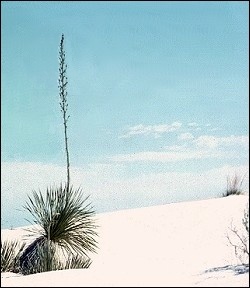

Think of deserts, and although you may have a vision of towering sand dunes, a rocky landscape is far more typical of deserts. However, it's the fields of sand that capture our imagination by their grace and beauty—and perhaps equally by their other-world aspect, a world devoid of life, ever changing.
The Chihuahuan Desert is blessed with many dune fields, and one of the larger in North America—Los Médanos de Samalayuca—lies in the state of Chihuahua, south of Juárez. Perhaps most widely known, of course, are the white gypsum dunes in the Tularosa Basin of southern New Mexico.
Like so many things in our desert, the dune fields tell a tale of our
desert's past climate, the sand tracing its ancestry back to the Ice Age, when
lakes dotted the landscape—lakes that died as the Ice Age waned to form the
playas of today. Stand amidst the dunes and look to the southwest, the direction of our
prevailing winds. What's there? Almost always, a vegetation-less expanse of old
lake bed, mother of sand dunes.

Contributor: Arthur H. Harris, Laboratory for Environmental Biology, Centennial Museum, University of Texas at El Paso.
Desert Diary is a joint production of the Centennial Museum and KTEP National Public Radio at the University of Texas at El Paso.

Gypsum sand dunes at White Sands National Monument. Photograph by A.H. Harris.